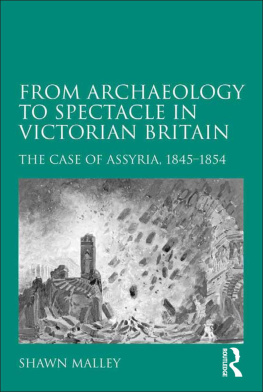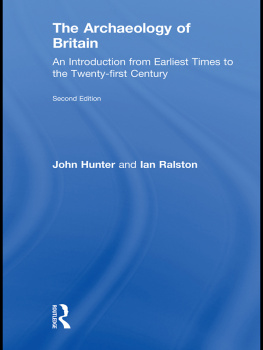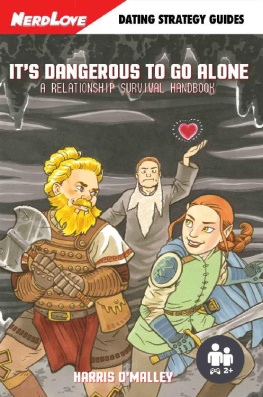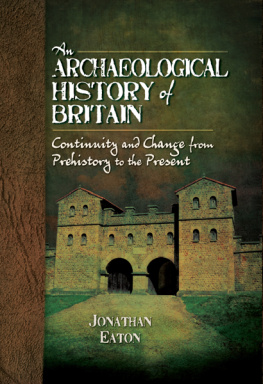FROM ARCHAEOLOGY TO SPECTACLE IN VICTORIAN BRITAIN
In his examination of the excavation of ancient Assyria by Austen Henry Layard, Shawn Malley reveals how, by whom, and for what reasons the stones of Assyria were deployed during a brief but remarkably intense period of archaeological activity in the mid-nineteenth century. His book encompasses the archaeological practices and representations that originated in Layards excavations, radiated outward by way of the British Museum and Layards best-selling Nineveh and Its Remains (1849), and were then dispersed into the public domain of popular amusements. That the stones of Assyria resonated in debates far beyond the interests of religious and scientific groups is apparent in the prevalence of poetry, exhibitions, plays, and dioramas inspired by the excavation. Of particular note, correspondence involving high-ranking diplomatic personnel and museum officials demonstrates that the treasures brought home to fill the British Museum served not only as signs of symbolic conquest, but also as covert means for extending Britains political and economic influence in the Near East. Malley takes up issues of class and influence to show how the middle-class Layards celebrity status both advanced and threatened aristocratic values. Tellingly, the excavations prompted disturbing questions about the perils of imperial rule that framed discussions of the social and political conditions which brought England to the brink of revolution in 1848 and resurfaced with a vengeance during the Crimean crisis. In the provocative conclusion of this meticulously documented and suggestive book, Malley points toward the striking parallels between the history of Britains imperial investment in Mesopotamia and the contemporary geopolitical uses and abuses of Assyrian antiquity in postinvasion Iraq.
First published 2012 by Ashgate Publishing
Published 2016 by Routledge
2 Park Square, Milton Park, Abingdon, Oxon OX14 4RN
711 Third Avenue, New York, NY 10017, USA
Routledge is an imprint of the Taylor & Francis Group, an informa business
Copyright Shawn Malley 2012
Shawn Malley has asserted his right under the Copyright, Designs and Patents Act, 1988, to be identified as the author of this work.
All rights reserved. No part of this book may be reprinted or reproduced or utilised in any form or by any electronic, mechanical, or other means, now known or hereafter invented, including photocopying and recording, or in any information storage or retrieval system, without permission in writing from the publishers.
Notice:
Product or corporate names may be trademarks or registered trademarks, and are used only for identification and explanation without intent to infringe.
British Library Cataloguing in Publication Data
Malley, Shawn.
From archaeology to spectacle in Victorian England : the case of Assyria, 18451854 1. Layard, Austen Henry, Sir, 18171894. 2. Excavations (Archaeology) Iraq History 19th century. 3. Excavations (Archaeology) Political aspects Iraq History 19th century. 4. Antiquities in popular culture Great Britain History 19th century. 5. Assyria Antiquities.
I. Title
930.10956709034-dc23
Library of Congress Cataloging-in-Publication Data
Malley, Shawn, 1967-
From archaeology to spectacle in Victorian Britain: the case of Assyria, 18451854 / by Shawn Malley.
p. cm.
Includes index.
ISBN 978-1-4094-2689-9 (hardcover: alk. paper) ISBN 978-1-3155-8327-3 (ebook)
1. AssyriaAntiquities. 2. AssyriaForeign public opinion, British. 3. Layard, Austen Henry, Sir, 18171894. 4. Excavations (Archaeology)IraqHistory19th century. 5. ArchaeologyPolitical aspectsGreat BritainHistory19th century. 6. ImperialismSocial aspectsGreat BritainHistory19th century. 7. ArchaeologistsGreat BritainBiography. 8. Public opinionGreat BritainHistory19th century. 9. AssyriaIn popular culture. 10. Popular cultureGreat BritainHistory19th century. I. Title.
DS69.6.M36 2012
935.03dc23
2011035635
ISBN 9781409426899 (hbk)
ISBN 9781315583273 (ebk)
ISBN 9781317132516 (ebk-ePUB)
The recent exhumation of her long-buried, and all but forgotten remains, has been the signal for a long and brilliant array of able lectures, sermons, and essays, such as would seem to indicate that all has been said that can be said to profit.
T. Dalton, The Light of Other Days, or, the Lesson of Nineveh, 1852
Hes big enough, isnt he, he remarked. They must have owned wonderful machinery to make a thing like that.
I expect so, said Maurice, also impressed by the bull. I couldnt tell you. Here seems to be another one.
A pair, so to speak. Would these have been ornaments?
This one has five legs.
Sos mine. A curious idea. Standing each by his monster, they looked at each other, and smiled.
E.M. Forster, Maurice
Acknowledgments
For their generous financial support and research assistance I thank Bishops University and the Social Sciences and Humanities Research Council of Canada. For archival help, much thanks goes out to Janet Wallace, Christopher Date, and Christopher Kent of the British Museum Central Archives, Drs. Julian Reade and Dominique Collon of the British Museum Department of Western and Asiatic Antiquities, and the helpful staff and archivists at the British Library Department of Manuscripts, the Victoria and Albert Museum, the Folger Shakespeare Library, the Public Records Office, Huntington Library, the National Archive of Scotland, the Historic Buildings and Monuments Commission for England, and the Bridgeman Art Library. I am also most grateful to Dr. Laurie Rush of the US Legacy Resources Management Program.
A special thanks also goes out to the Offices of Research and the Vice Principal, to Sylvie Cot, Cheryl Porter, the staff of Bishops Library, and my colleagues in the Department of English. Many thanks to my research assistants Sunita Nigham, Grace Mazzocca, James Hatch, and Adam Young, and, for photographic assistance, Melanie Hattie.
For their collaborations, discussion, and suggestions over the years I am most grateful to Drs. Robert Aguirre, Andrew Stauffer, Frederick Bohrer, Zainab Bahrani, Michael Childs, and Amatzia Baram. And, for their unflagging support, my father and mother-in-law, Tony and Susanna Mazzocca. I would also like to express my appreciation to the Ashgate team and to my editors, Ann Donahue and Seth F. Hibbert, whose guidance was instrumental in bringing this project to completion.
My gratitude, most of all, goes to Grace Mazzocca, who has helped me in so many ways through this journey. For your companionship, confidence, insights, and for all those late nights and early mornings along the way, it is to you that this work is, and has always been, dedicated.
Shawn Malley
Sherbrooke, Quebec











